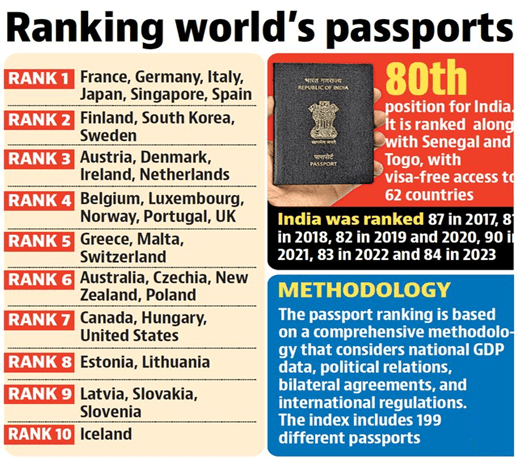- The Curious Club
- Posts
- The Four Indian Passports
The Four Indian Passports
India is the fifth largest economy in the world but the Indian passport ranks 80th in the Henley Passport Index 2024, offering visa-free or visa-on-arrival access to only 62 destinations in the world in comparison to the countries such as UK, the sixth largest economy in the world, ranks 4th on the Passport Index with access to 191 countries, and France, the seventh largest economy in the world, ranks 1st on the list with access to 194 countries visa-free or via visa-on-arrival arrangements.

IHenley Passport Index 2024
A passport is a precious document. It allows you to travel to any place that is outside the borders of your own territory. But passports are not just travel documents; they are also a symbol of national identity and sovereignty. Passports hold power and also, the key to global mobility and provide consular protection for citizens worldwide. As of 2024, more than 30 million Indian citizens hold valid passports, reflecting a significant increase in passport issuance over the past few years. But did you know that there are four types of Indian passports? Not just the classic blue one we see, but there are 3 more types of Indian passports that are issued to Indians.
The Indian passport is an essential travel document authorized by the Government of India. It is issued by the Ministry of External Affairs of the Republic of India to Indian citizens for international travel. The Indian passport serves as proof of Indian citizenship as per the Passports Act (1967). Even before the independence of India, passports were issued to Indians by the British Empire. In fact, the first passport act in India was launched in 1920, after the First World War, by the British. Under the Indian Passport Act of 1920, the British Indian passport that was issued had very limited usage, validating travel only within the British Empire, Italy, Switzerland, Austria, Czechoslovakia, Germany, France, Spain, Norway, Sweden, and Holland. (Fun fact: There are only 22 countries in the world that were never invaded by the British Empire.)

The British Indian passports issued after the First World War
The use of these British Indian passports was discontinued in 1947, and the bearers of the British Indian passports were entitled to opt for either Indian, Pakistani, or British nationality. As India functioned as an independent nation, the use of passports and the laws to protect Indians became important. The passport laws became stricter in both countries in 1952. Till 1967, Indian passports were granted only to "respectable" people, people who were educated, and those who didn’t belong to the Communist Party of India. It’s surprising to know that not everyone had the right to a passport. Classism has been omnipresent in India for a really long time. Only in 1967, after the Passports Act was enacted, did the Supreme Court rule that every citizen had the right to a passport.
The Indian passport underscores India's commitment to serving its citizens and promoting their interests on the global stage. There are two categories of Indian passports, which are digital/online ePassports and offline/physical passports. In the physical passport category, there are primarily 4 types of Indian passports in the colors blue, white, orange, and maroon. Each of these passports comes with its own responsibilities and the kind of opportunities it opens up for the individual based on their eligibility.

The classic blue Indian passport is also known as the Type-P passport, where P stands for personal- Indian citizens traveling for personal reasons, be it studies, travel, or leisure. This passport is the one that is issued to most of us and is the most commonly issued and used passport in India. The White Service Passport is the most powerful Indian passport of all the types of passports, and it is only issued to people who work for the Indian government. It is a Type-S passport, where S stands for service. Officials who travel outside India on official travel use the white passport. Commonly, the White Indian Passport is issued to IAS and IPS Department officials.
The orange Indian Passport was launched in 2018 for those individuals who have not completed their education beyond the 10th standard. These passports are ECR passports, where ECR stands for Emigration Check Required. The orange passport protects the holder from exploitation at overseas workplaces. The deep maroon passports are Type- D passports, where D stands for Diplomat. The maroon passport is issued only to Indian diplomats, Members of Parliament, Union Council of Ministers, and government officials with high-ranking diplomatic careers, and they are not required to apply for a visa, no matter the duration of the stay. High-ranking state-level Indian officials on official business can also request and apply for a diplomatic passport. All the diplomatic passports, for example, the Maroon Indian passports, have become e-passports since 2008.
Apart from these physical passports, a new type of passport, also known as e-passports, is also being authorized by the Government of India. An e-passport is a passport that combines traditional paper elements with electronic features. It includes a Radio Frequency Identification (RFID) chip and an antenna embedded within the passport's pages. This chip contains the passport holder's personal details and biometric information, such as name, date of birth, photo, and other information. The issuance of e-passports in India began in 2021. India has already issued 20,000 e-passports to diplomats and officials to test it out. The embedded chip enhances security and allows for faster processing at border controls to improve the efficiency of international travel.

Reply